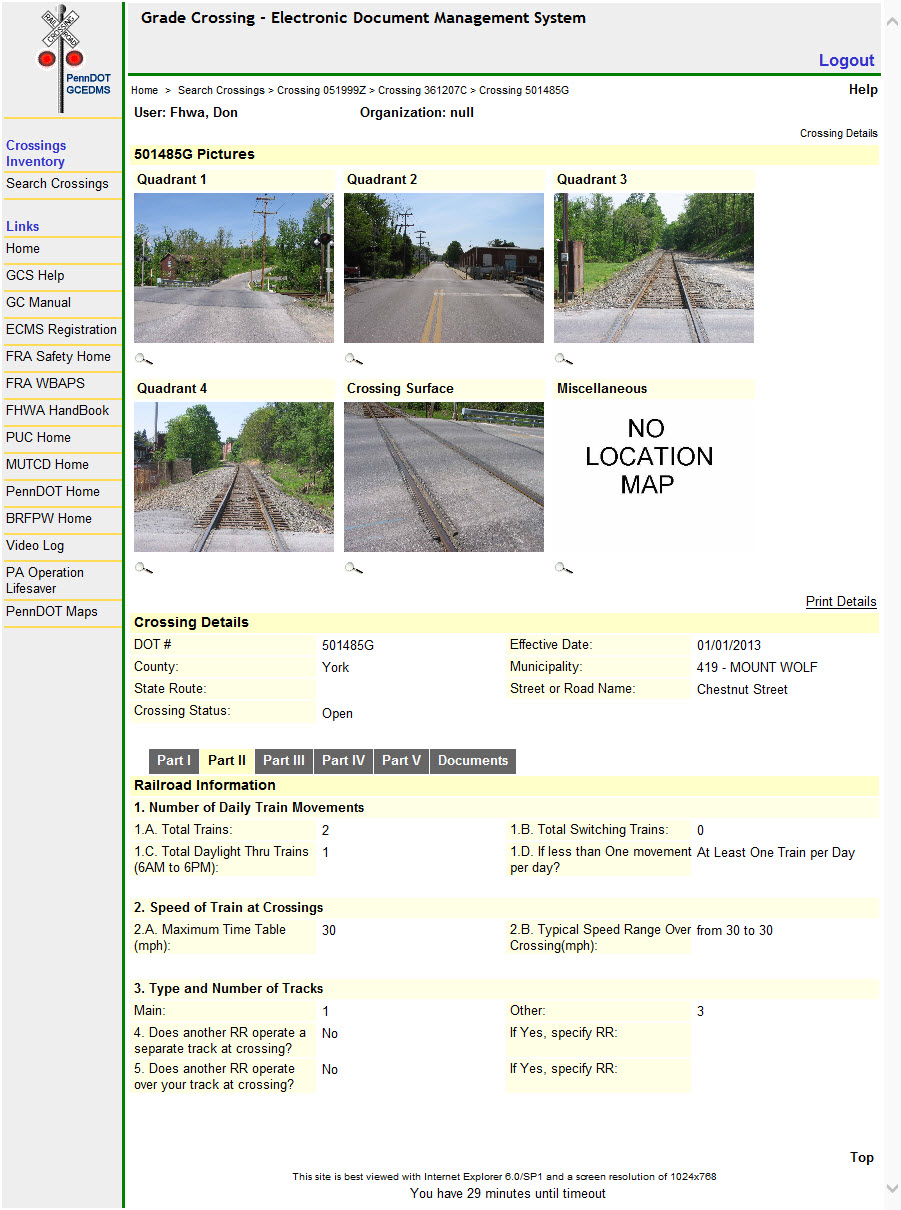
Clicking the DOT # link on the Search Crossings page displays the Crossing Details page. The latest crossing pictures appear at the top of the page. Crossing Details are displayed in different tabs. Each tab represents a separate section on the U.S. DOT Crossing Inventory Form. PUC documents also appear on a separate tab. Clicking a tab name displays its contents.

Click a link to jump to the topic.
The Pictures section displays thumbnails of crossing pictures for:
Quadrant 1
Quadrant 2
Quadrant 3
Quadrant 4
Crossing Surface
Miscellaneous
Each picture has the following control:
Hold your mouse pointer over a picture's magnifying glass icon ![]() to display a larger version of the picture. Click this larger picture to open the full size picture in a new window.
to display a larger version of the picture. Click this larger picture to open the full size picture in a new window.
Print Details - Click this link to display the Print Crossing Details page, a printer friendly version of all information on Part I-Part V Tabs (Part I only for non-at grade crossings).
DOT # - The crossing identification number.
Effective Date - The date the crossing information was last updated.
County - The county the crossing is located in.
Municipality - The municipality the crossing is located in.
State Route - The state route that intersects the crossing.
Street or Road Name - The name of the street that intersects the crossing.
Crossing Status - The status of the crossing, open or closed.
Note: All information in the Crossing Details tabs is read only for railroad users.
1. Number of Daily Train Movements
1.A. Total Trains - (READ ONLY) Total Trains are the total of the number of through trains and switching trains (per day) through the crossing during normal railroad operating periods.
1.B. Total Switching Trains - (READ ONLY) Total Switching Trains are the number of switching trains through the crossing (per day) during normal railroad operating periods.
1.C. Total Daylight Thru Trains (6AM to 6PM) - (READ ONLY) Total Daylight Thru Trains are the number of through trains through the crossing between the hours of 6 AM and 6 PM.
Typical number of daily train movements means the normal or average daily train movements. “Through Trains” are trains whose primary responsibility is to move cars over the road, and there may be a limited number of pickups and setouts along the route. Classify all others, (i.e., locals, industrial runs, switch engine) as switching movements. Include the total number of the train movements both for the reporting "operating" railroad and for any other railroad operating over the crossing.
1.D. If less than One movement per day? - (READ ONLY) Indicates whether train frequency is less than one train per day.
2. Speed of Train at Crossings
2.A. Maximum Time Table (mph) - (READ ONLY) The maximum timetable speed in miles per hour (mph). This field must not be less than the value in Item 2.B, Typical Speed Range Over Crossing.
2.B. Typical Speed Range Over Crossing (mph) - (READ ONLY) The typical minimum speed (“from”) over the crossing in miles per hour (mph). This must be less than the maximum timetable speed in Item 2.A.
The typical maximum speed (“to”) over the crossing. This cannot be greater than the maximum timetable speed in Item 2.A. and cannot be less than the typical minimum speed range.
3. Type and Number of Tracks
Main and Other - (READ ONLY) The number of main line tracks and specify the number and type of any “Other” tracks. A track is considered main if through trains operate on the track. If “Other,” specify.
4. Does another RR operate separate track at crossing? - (READ ONLY) Indicates whether another railroad operates a separate track at the crossing. If “Yes,” enter the FRA railroad code for all railroads that operate a separate track within the warning devices at the crossing. Up to four railroad codes, in codes of up to four characters each, may be entered in this field.
5. Does another RR operate over your track at crossing? - (READ ONLY) Indicates whether another railroad operates over the track at the crossing. If Yes, enter the FRA railroad code for all railroads that operate trains over the track at the crossing. Up to four railroad codes, in codes of up to four characters each, may be entered in this field.